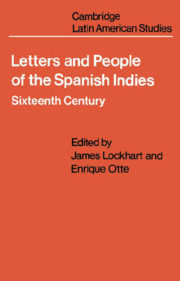Book contents
- Frontmatter
- Contents
- Preface
- Part I Conquest
- Part II The Variety of Life in the Indies
- 11 An encomendero's establishment
- 12 An encomendero's opinions
- 13 The miner
- 14 Commerce across the Atlantic
- 15 The professor of theology
- 16 The new arrival
- 17 The tanner and his wife
- 18 The troubadour
- 19 The nephew
- 20 The garden and the gate
- 21 The woman as settler
- 22 The farmer
- 23 The petty dealer
- 24 The Flemish tailors
- 25 The nobleman
- 26 The Hispanized Indian
- 27 Indian high society
- 28 An Indian town addresses the king
- Part III officials and Clerics
- Bibliography
- Index
24 - The Flemish tailors
from Part II - The Variety of Life in the Indies
Published online by Cambridge University Press: 06 August 2018
- Frontmatter
- Contents
- Preface
- Part I Conquest
- Part II The Variety of Life in the Indies
- 11 An encomendero's establishment
- 12 An encomendero's opinions
- 13 The miner
- 14 Commerce across the Atlantic
- 15 The professor of theology
- 16 The new arrival
- 17 The tanner and his wife
- 18 The troubadour
- 19 The nephew
- 20 The garden and the gate
- 21 The woman as settler
- 22 The farmer
- 23 The petty dealer
- 24 The Flemish tailors
- 25 The nobleman
- 26 The Hispanized Indian
- 27 Indian high society
- 28 An Indian town addresses the king
- Part III officials and Clerics
- Bibliography
- Index
Summary
Pedro de Anver to a compatriot in Cuzco, 1547
… J os del Miere says you should be sure to come to his house …
'Foreigners,’ that is, non-Spanish Europeans, were a minority in the Spanish Indies, held in low esteem and often drifting towards marginal areas and occupations, but they were a standard phenomenon nonetheless, appearing everywhere, quite essential to the Spaniards as mariners and in certain specialized trades. Over time, they melted into the lower and middle reaches of the Spanish population, losing their distinctiveness. But in the first generation, precisely because they were in such a minority position, lines of common ethnicity and craft structured their lives, even more than with the Spaniards. The Greek gunners were one world, the Genoese sailors another, the Flemish silversmiths another; inside that framework each group had its principal friends, enemies, and business connections. Those little worlds had great cohesion and independence, and were not easily disturbed by even cataclysmic events outside.
Here, our world is that of Flemish clothing makers in Peru. The writer, ‘Peter of Antwerp,’ is a tailor, and so is the Maestre Diego Flamenco (Master Jacob Fleming) who is mentioned. Jos del Miere (Joos van der Meer) is a hosier, while the recipient of the letter seems to be more of a producer of leather items. They write and visit each other; they give each other news on prices and demand; they use each other as a business network to collect debts from Spaniards around the country for whom they have done work; and they come into conflict with each other, since we see that Maestre Diego has had the man in Cuzco thrown into jail for a debt. At this time, 1547, Peru was under the rebel government of Gonzalo Pizarro and was approaching the climax of its most shattering civil war. There is some mention of this in the letter, along with some rather poorly informed gossip, that ‘Dr,’ actually Licentiate, Gasca had arrived in the north with ‘a few’ men, actually plenty to attract the whole of Spanish Peru to the royal side in quite short order. And indeed, Maestre Diego was quite heavily involved in the rebellion itself. But the emphasis is on visits, prices, loans, and family news: Jos del Miere's wife has had a baby.
- Type
- Chapter
- Information
- Letters and People of the Spanish IndiesSixteenth Century, pp. 146 - 148Publisher: Cambridge University PressPrint publication year: 1976



